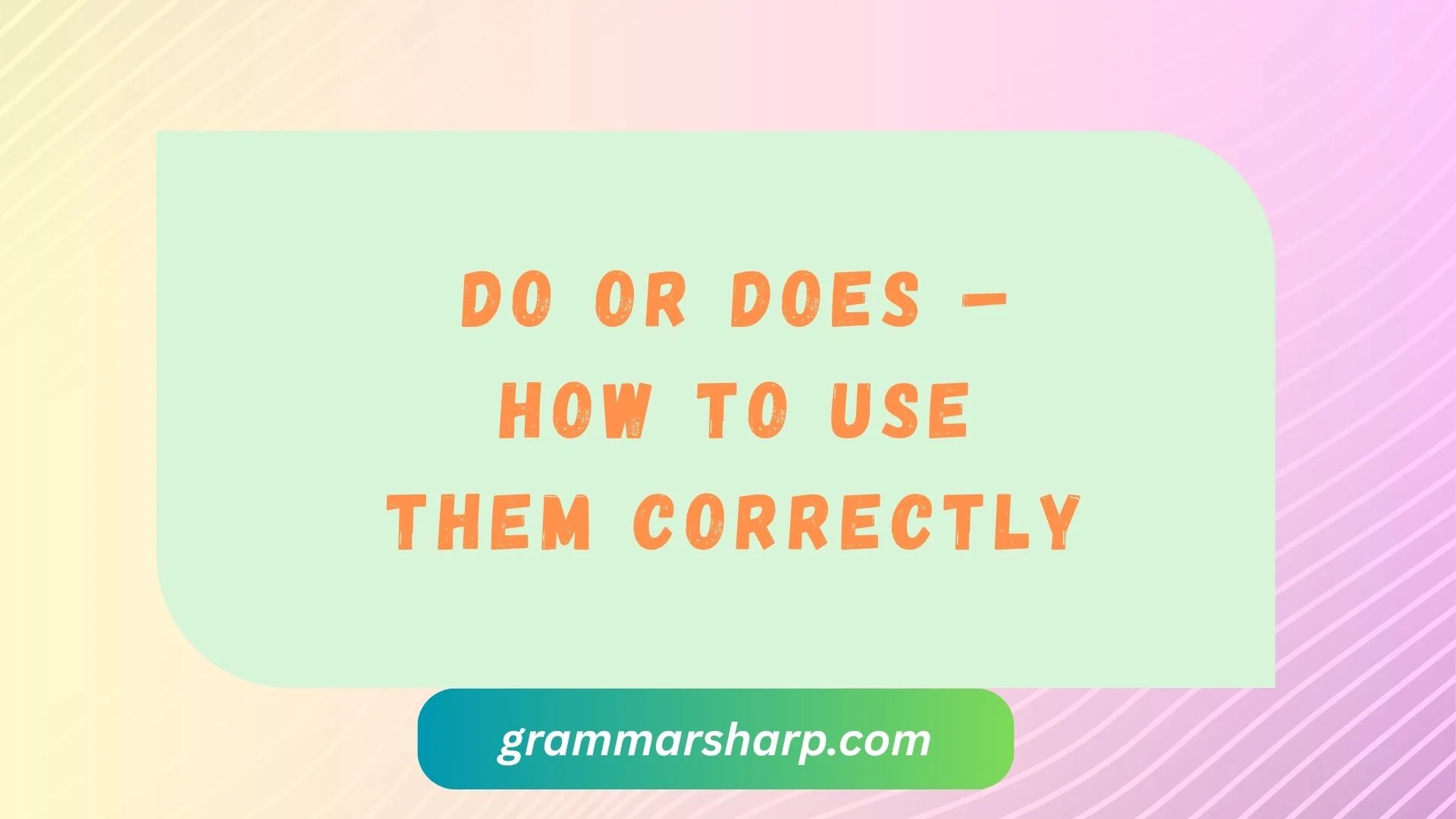English learners often stumble when deciding whether to use do or does. At first glance, these two little words seem simple. Yet they carry a lot of weight in grammar, especially when forming questions, negatives, and emphatic statements. The confusion usually arises because English verbs change slightly depending on the subject. If you’ve ever wondered, “Should I say do or does?”, you’re not alone.
Think about conversations in everyday life. You might ask someone, “Do you like coffee?” Or you could say, “Does she work here?” Both sentences look similar, but one uses do and the other does. Knowing which form to use makes your English sound natural and professional. Misusing them, on the other hand, can create misunderstandings or make sentences feel awkward.
This guide covers everything you need to know about using do and does correctly. You’ll learn the grammar rules, see plenty of examples, and discover common mistakes to avoid. We’ll also explore how these words change in different tenses, how they appear in idioms, and even how to use them for emphasis.
By the end of this article, you’ll have a complete toolkit to master these forms of the verb “to do.” You’ll not only understand the rules but also gain confidence to use them in both writing and speech.
Whether you’re preparing for an English exam, improving professional communication, or simply polishing your everyday conversations, this detailed breakdown will help you. So let’s dive into the fascinating world of do and does, two small but mighty helpers in the English language.
The Basics of Do and Does
At their core, do and does are both present simple forms of the verb “to do.”
- Do is used with the subjects I, you, we, and they.
- Does is used with the subjects he, she, and it.
These words often serve as auxiliary verbs, meaning they help form questions, negatives, or emphatic statements. But they can also function as main verbs, meaning “perform” or “carry out.”
For example:
- Auxiliary use: Do you know the answer?
- Main verb use: She does her homework every evening.
Understanding this dual role helps you see why do and does appear so frequently in English.
Subject–Verb Agreement Rules
The golden rule is simple:
- Use do with plural subjects (except you which always takes do).
- Use does with third-person singular subjects (he, she, it).
Here’s a quick reference table:
| Subject | Correct Form | Example |
| I | do | I do my homework every day. |
| You | do | You do know the answer. |
| We | do | We do enjoy playing soccer. |
| They | do | They do their chores. |
| He | does | He does the cooking. |
| She | does | She does yoga in the morning. |
| It | does | It does look interesting. |
Think of it this way: if the subject is third person singular, you need does. For everything else in present tense, do is your choice.
Do vs. Does in Questions

Questions are one of the most common places where learners get confused. The rule is straightforward:
- Use do for I, you, we, they.
- Use does for he, she, it.
Yes/No Questions
- Do you like pizza?
- Do they live nearby?
- Does he play guitar?
- Does she know the answer?
Wh-Questions
- What do they want?
- Where do you go on weekends?
- Why does she always smile?
- When does it start?
Quick Tip
After do or does, the main verb always stays in its base form. Never add “-s” or “-ed.”
❌ Does she sings well?
✅ Does she sing well?
Do vs. Does in Negative Sentences
Negative forms follow this structure: do/does + not + base verb.
- I do not (don’t) understand.
- They do not (don’t) agree.
- She does not (doesn’t) like spicy food.
- It does not (doesn’t) matter.
Notice again that the verb after does does not take “-s.” The auxiliary verb does already shows agreement with the subject.
Common Contractions
- don’t = do not
- doesn’t = does not
Contractions are very common in spoken English and informal writing. Using them makes your sentences sound more natural.
Emphatic Use of Do and Does
English speakers often use do or does to add emphasis in positive sentences.
Examples:
- I do like chocolate, even if it’s unhealthy.
- She does care about her work, more than you think.
- We do want to join you, but we’re busy.
The emphatic use adds feeling or stress. It shows you want to strongly confirm or defend something.
Common Mistakes with Do and Does
Even advanced learners slip up when using do and does. Here are the mistakes to avoid:
- ❌ She does goes to school every day.
She does go to school every day. - ❌ Does you like this movie?
Do you like this movie? - ❌ They does not agree.
They do not agree.
Key Tip: Always use the base verb after do/does. Never add “s,” “ed,” or “ing” in this structure.
Comparing Do and Does with Other Verb Tenses
It’s important to see how do and does compare with other forms of the verb to do.
- Past tense → did
- Did you watch the game last night?
- Present continuous → is doing / are doing
- He is doing his homework.
- Future tense → will do
- They will do the cleaning tomorrow.
This comparison highlights that do and does are used only in present simple tense.
Idioms and Phrases with Do and Does
English is full of idiomatic expressions using do and does. These phrases often don’t follow strict grammar logic but carry specific meanings.
Popular idioms include:
- Do your best – Give your maximum effort.
- Do me a favor – Help me with something.
- Do the math – Figure out the facts.
- Does the trick – Works perfectly.
- Do time – Serve a prison sentence.
- Do away with – Eliminate or remove.
For example:
- Drinking water regularly does the trick for clear skin.
- He promised to do his best in the competition.
Learning idioms improves fluency and makes your English sound more natural.
Quick Reference Guide (Cheat Sheet)
Here’s a handy cheat sheet to remember:
- Use do with I, you, we, they.
- Use does with he, she, it.
- Always use the base verb after do/does.
- For negatives: add “not” → don’t / doesn’t.
- For questions: start with do/does, then subject, then base verb.
Practice Exercises
Fill in the blanks:
- ____ you know the answer?
- She ____ not like spicy food.
- We ____ enjoy long walks in the park.
- ____ he play soccer?
- They ____ not want to leave early.
Rewrite these sentences correctly:
- She does likes apples.
- Does you know the way?
- They does not agree.
Answer Key
- Do you know the answer?
- She does not like spicy food.
- We do enjoy long walks in the park.
- Does he play soccer?
- They do not want to leave early.
Corrections:
- She does like apples.
- Do you know the way?
- They do not agree.
Conclusion
Choosing between do and does may feel tricky at first, but the rules are simple once you practice. Remember, do goes with I, you, we, they. Does goes with he, she, it. Always keep the main verb in its base form when using these helpers.
Mastering this distinction helps your English sound smoother and more accurate. Whether you’re asking questions, making negatives, or emphasizing a point, knowing when to use do or does is essential.
The more you practice, the more natural it becomes. Soon, you won’t even think twice before using them correctly.
FAQs
What’s the past tense of “do” and “does”?
The past tense is did for all subjects. Example: Did you see her yesterday?
Can “does” ever be used with “I”?
No. With “I,” always use do. Example: I do my work daily.
Is “doesn’t” formal or informal?
Doesn’t” is a contraction, common in spoken and informal English. In formal writing, use “does not.”
What’s the difference between “do” as a verb and “do” as an auxiliary?
As a verb, it means “perform.” Example: I do my homework. As an auxiliary, it helps form questions and negatives. Example: Do you understand?
Why can’t we say “Does she goes”?
Because after does, the verb must stay in base form: Does she go?

